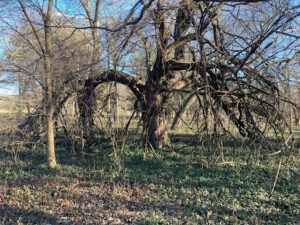By: Mark Halpin, Forestry Manager
There’s nothing interesting about perfection. Artists and artisans have understood this for a long time – the intricate weaving traditions of the Persians, the Navajo, and Phulkari of India intentionally include minor imperfections in their works. The geometric artwork of some mosques and synagogues includes a similar tradition. Ancient Greek architects knew that for a building to look perfect it couldn’t actually be perfect. Piano tuners likewise stray a bit from true perfect tuning because it sounds “off”. The Japanese have developed an entire philosophy of aesthetics around the celebration of imperfection, “wabi sabi”. According to this philosophy, perfection is not natural, because nature is always in the act of becoming. Nothing is ever complete, and we must accept that to fully embrace life.
 The art of bonsai includes 6 techniques for intentional scarring and inclusion of deadwood in trees. Sharamiki, “driftwood style”, describes the silvery, aged wood as seen here. Image from inside the tree shown below.
The art of bonsai includes 6 techniques for intentional scarring and inclusion of deadwood in trees. Sharamiki, “driftwood style”, describes the silvery, aged wood as seen here. Image from inside the tree shown below.
Every arborist carries in their mind a “Perfect Tree Template”- a strong central leader, well-spaced and proportioned branches free of included bark, no wounds or defects, and visible root flair. This is the structure we aim for in pruning, and the standard we use to judge risk and hazard. Most of us recognize that, like any ideal, it is something to aspire to rather than actually realize. We also mostly agree that while it’s the strongest structure for a tree, it’s not really the most interesting to look at. If you want interesting, look at this beautiful monstrosity:
 An almost-perfect example of the beauty of imperfection.
An almost-perfect example of the beauty of imperfection.
This tree violates our template in nearly every way. The central leader has broken, and a huge decay column runs from the ground into its branches, which are too long and thick. The main trunk is hollow, and the branches 30-50% dead wood encased with live tissue. This is literally a shell of a tree. The lower branch on the left can’t even hold itself up anymore! This lazy bum requires two 4×4” deck posts and something resembling a wooden jack stand to stay off the ground. And it’s a catalpa (C. speciosa, northern catalpa), a tree maligned for its large bean pods, it’s messy flowers (because a blanket of colorful, fragrant flowers on the ground is apparently a “mess” to some people), its weediness, and its tendency to become hollow with age. So why is it still standing? What’s more, why has someone expended such energy into propping it up?
 Like a besotted drunk being carried from the bar by his long-suffering friends…
Like a besotted drunk being carried from the bar by his long-suffering friends…
When a tree’s failure could lead to serious human injury or property damage, it’s structural integrity is paramount. Street trees, trees in yards, next to playgrounds or other areas with many potential “targets” must be held to a higher standard. When failure means some damaged grass, as is the case with this catalpa, we can play by a different set of rules. We can be guided by aesthetics and ecological idealism. There are instances where leaving a tree like this standing would be irresponsible. In a park or natural setting, I would argue that it would be irresponsible to remove it. It would be a desecration of nature and an insult to beauty. If you’re more easily swayed by numbers, it would also deprive us of measurable ecological benefits. These can’t be replaced by a new planting; older trees sequester more carbon* and support more wildlife. This tree’s benefits would take decades to recoup.
 ;Composed almost entirely of woundwood – a sign of health and vitality. Woundwood is in some cases stronger than normal tissue. It’s also more interesting to look at.
;Composed almost entirely of woundwood – a sign of health and vitality. Woundwood is in some cases stronger than normal tissue. It’s also more interesting to look at.
Flaws don’t automatically make a tree more interesting though – not every injury or imperfection is beautiful. There’s some mysterious balance between health and calamity that creates this aesthetic quality. Some trees just look sad, and we yearn to do some corrective pruning, and some plant health care treatments to nurse them back. This catalpa stands proud. It may be half dead and broken, but its wounds are its most beautiful features. The living tissue surrounds the dead, decayed wood – what else could so perfectly capture the essence of wabi sabi, and life itself? Whatever that balance is, this tree has achieved it. It will slowly but surely fall apart, until it finally sinks into the earth with the glory of a setting sun.
 How could anyone even think of destroying the home of the Keebler Elves?
How could anyone even think of destroying the home of the Keebler Elves?
In bonsai this tree would be described as having sabamiki, hollow trunk, shari and sharamiki for the dead, silvery “driftwood” like portions of the trunk, and jin for the damage to the upper limbs. These scars make it what it is – a tree you can marvel at for hours. Located just east of the intersection of Center Cross and Arsenal in Tower Grove Park, this tree is a local legend and a must-see.
*(Stephenson, N., Das, A., Condit, R. et al. Rate of tree carbon accumulation increases continuously with tree size. Nature 507, 90–93 (2014). https://doi.org/10.1038/nature12914).



